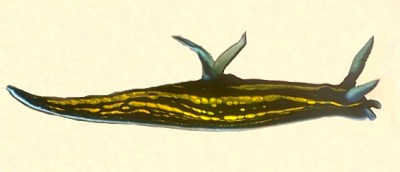
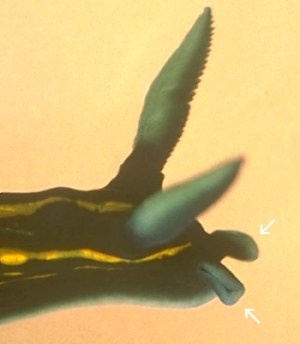
Roboastra gracilis
(Bergh, 1877)
Order: NUDIBRANCHIA
Suborder: DORIDINA
Superfamily: ANADORIDOIDEA
Family: Polyceridae
Subfamily: Nembrothinae
DISTRIBUTION
Tropical West Pacific.
PHOTO
Lizard Is, North Queensland, Great Barrier Reef, June 1979. Lower photo showing large enrolled oral tentacles. PHOTOS: Bill Rudman.
Relatively small nembrothid, growing to about 20-25mm in length. Characterised by the yellow longitudinal lines which are sometimes quite onscure. These lines consist of a series of glandular pits which secrete a bright yellow substance when disturbed. Although I have no feeding records this species is a member of a genus which hunts down and eats other opisthobranchs. The large oral tentacles (arrowed) are found in all members of Roboastra and are probably important in tracking down their prey, perhaps by following its mucus trail.
Reference:
• Bergh, L.S.R. (1877). Malacologische Untersuchungen. In: C.G. Semper, Reisen im Archipel der Philippinen, Wissenschaftliche Resultate. Band 2, Heft 11: 429-494, Pls. 54-57.
Rudman, W.B., 2000 (July 17) Roboastra gracilis (Bergh, 1877). [In] Sea Slug Forum. Australian Museum, Sydney. Available from http://www.seaslugforum.net/find/robograc
Related messages
Roboastra gracilis from Mozambique
August 7, 2008
From: Valda Fraser
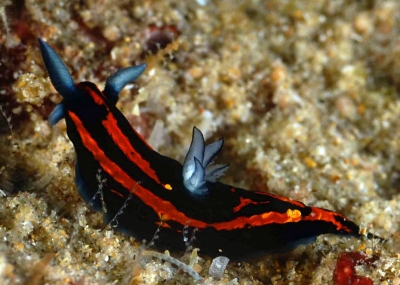
Dear Bill
Please confirm the identification of this nudibranch. I think it is Roboastra gracilis. Thanks.
Locality: Ponta, 15 m, Mozambique, Indian, 16 June 2008, Reef. Length: 35 mm. Photographer: Valda Fraser.
Regards
Valda
valdafraser@mweb.co.za
Fraser, V.J., 2008 (Aug 7) Roboastra gracilis from Mozambique. [Message in] Sea Slug Forum. Australian Museum, Sydney. Available from http://www.seaslugforum.net/find/21768Thanks Valda,
Yes this is R. gracilis.
Best wishes,
Bill Rudman
Re: Roboastra gracilis from Thailand.
February 7, 2008
From: K. Kalani Patterson
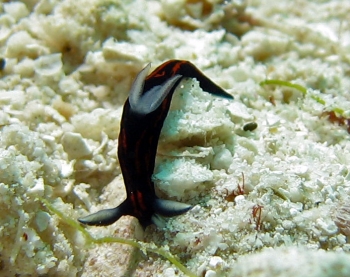
Concerning message #20071:
I have a shot of a Roboastra gracilis from Thailand as well (Racha Noi island near Phuket) that is definitely red. So they're out there!
Locality: Racha Noi island, 50 feet, Phuket, Thailand, Andaman Sea, 20 January 2008, Sandy. Length: 1.5 inches. Photographer: K. Kalani Patterson.
K. Kalani Patterson
kalani@kalani.net
Patterson, K.K., 2008 (Feb 7) Re: Roboastra gracilis from Thailand.. [Message in] Sea Slug Forum. Australian Museum, Sydney. Available from http://www.seaslugforum.net/find/21354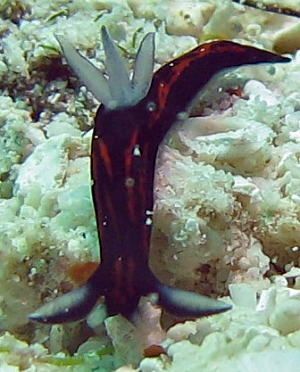
Thanks Kalani,
It certainly seems to range in colour from yellow to 'almost red' markings
Best wishes,
Bill Rudman
Roboastra gracilis from Indonesia
September 21, 2007
From: Edward F Dixon
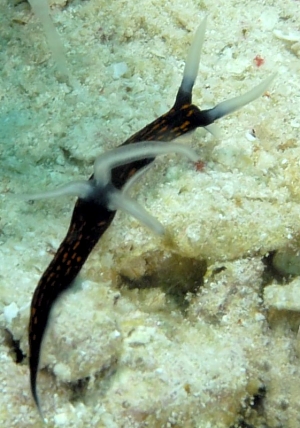
Bill and all --
Another from my Wakatobi trip. I believe, based on looking at a lot of pics, it's Roboastra gracilis ... but it's very slender compared to other pics, and the orange spots are barely visible on this specimen. Maybe a juvenile?
Locality: Wakatobi, 40 feet, Indonesia, Banda Sea, 31 October 2007, Sandy bottom. Length: > 2 inches. Photographer: E.F. Dixon.
Edward F Dixon
efdixon@yahoo.com
Dixon, E.F., 2007 (Sep 21) Roboastra gracilis from Indonesia. [Message in] Sea Slug Forum. Australian Museum, Sydney. Available from http://www.seaslugforum.net/find/20693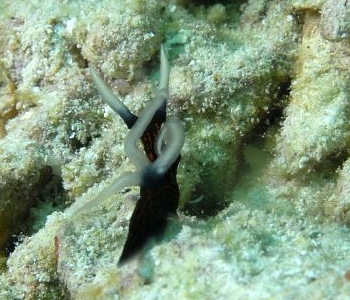
Dear Ed,
This is a perfectly acceptable R. gracilis. They tend to 'fatten up' when they are sitting still, and because they are so slender we often unconsciously wait until they shorten a bit or turn a little so they fill the photo frame better. The brightness of the yellow spots is quite variable, as is the 'blueness' of the gills and rhinophores.
Best wishes,
Bill Rudman
Roboastra gracilis from East Malaysia
July 16, 2007
From: Mike Krampf
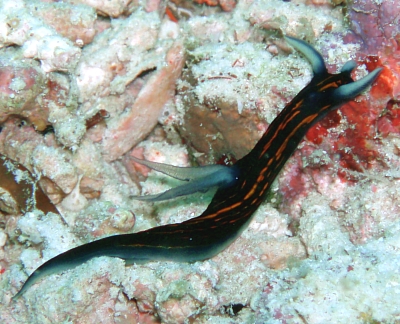
Concerning message #20071:
Here are some pics from a dive site off Mataking Island off the coast of East Malaysia that also have reddish lines.
Locality: Dive Site - Sweetlips Rocks, 50 ft, Mataking Island, Sabah, Malaysia, Celebes Sea, 2 February 2007, Fringing reef. Length: 4 cm. Photographer: Mike Krampf.
Cheers,
Mike
mtkrampf@yahoo.com
Krampf, M., 2007 (Jul 16) Roboastra gracilis from East Malaysia. [Message in] Sea Slug Forum. Australian Museum, Sydney. Available from http://www.seaslugforum.net/find/20080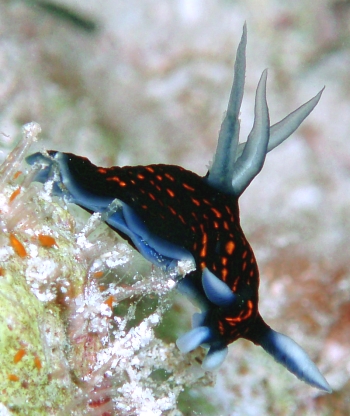
Thanks Mike,
Best wishes,
Bill Rudman
Re: Roboastra gracilis from Thailand.
June 27, 2007
From: Vie Panyarachun
Concerning message #19984:
"I thought the reddish parts in Asther Lau's photos were something to do with the camera lighting. If your animal actually had lines as red as in the photos it is a very unusual colour form."
Hi Dr. Rudman,
IN answer to your comments, I've seen three tiny Roboastra gracilis in the Similans (three separate locations) and they all had very red lines on the body. Unfortunately I had a camera with me on only one of those occasions.
Vie Panyarachun
vpanyarachun@hotmail.com
Vie Panyarachun, 2007 (Jun 27) Re: Roboastra gracilis from Thailand.. [Message in] Sea Slug Forum. Australian Museum, Sydney. Available from http://www.seaslugforum.net/find/20071Thanks Vie,
It would be interesting to know if you ever find specimens with the more usual yellow or yellow-orange lines. The only other photos I have seen of animals with reddish lines are specimens from Mozambique and South Africa [message #13250 ] so perhaps in the Indian Ocean region this reddish colour prevails. It will be interesting to see if anyone else has photos of animals with these reddish lines.
Best wishes,
Bill Rudman
Roboastra gracilis from Thailand.
June 26, 2007
From: Vie Panyarachun
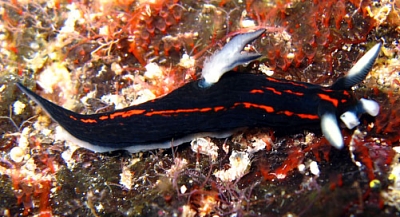
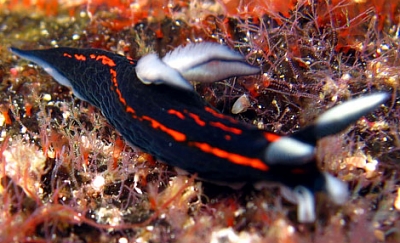
Concerning message #10874:
Found this Roboastra gracilis at Hin Pae/Shark Fin Reef in the Similans. It has red longitudinal lines similar to the example from Malaysia.
Locality: Hin Pae/Shark Fin Reef, Similan Islands, approx. 15 msw, Thailand, Andaman Sea, 9 April 2007. Length: approx 1.5". Photographer: Vie Panyarachun.
Vie Panyarachun
vpanyarachun@hotmail.com
Panyarachun, V., 2007 (Jun 26) Roboastra gracilis from Thailand.. [Message in] Sea Slug Forum. Australian Museum, Sydney. Available from http://www.seaslugforum.net/find/19984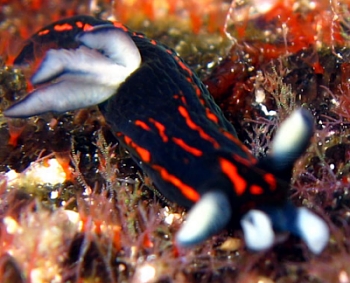
Thanks Vie,
I thought the reddish parts in Asther Lau's photos were something to do with the camera lighting. If your animal actually had lines as red as in the photos it is a very unusual colour form.
Best wishes,
Bill Rudman
Roboastra gracilis from Heron Island
May 16, 2006
From: Simon D. Power
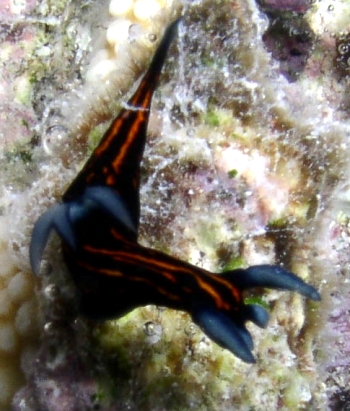
Dear Bill
I found this nudibranch on the outer reef flat at Heron Island in April of this year. I looked through your forum and several books and have been unable to identify it. I would greatly appreciate your help in determining its identrity.
Locality: Heron Island, 20cm, Intertidal, Australia, Pacific ocean, 18 April 2006, Intertidal reef flat. Length: 4cm. Photographer: Simon David Power.
Many thanks,
David
davidpower_@hotmail.com
Power, S. D., 2006 (May 16) Roboastra gracilis from Heron Island. [Message in] Sea Slug Forum. Australian Museum, Sydney. Available from http://www.seaslugforum.net/find/16614Dear David,
This is Roboastra gracilis, which feeds on other nudibranchs - mainly its close relatives, species of Tambja.
Best wishes,
Bill Rudman
Roboastra gracilis on Scorpion Fish
February 25, 2006
From: Aaron Smith
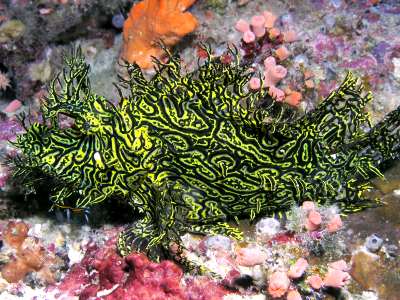
Concerning message #15816:
Here is a photo of Roboastra gracilis on Rhinopias Scorpionfish seen on Pixie Pinnacle on recent Cod Hole trip on board Nimrod Explorer. The Rhinopias has been there for over six months, but this time he had a companion.
Locality: Pixie Pinnacle, 7 metres, Queensland, Coral Sea, 28th December 2005, Outer reef. Photographer: Aaron Smith.
Aaron Smith
allyazza@optusnet.com.au
Smith, A., 2006 (Feb 25) Roboastra gracilis on Scorpion Fish. [Message in] Sea Slug Forum. Australian Museum, Sydney. Available from http://www.seaslugforum.net/find/15941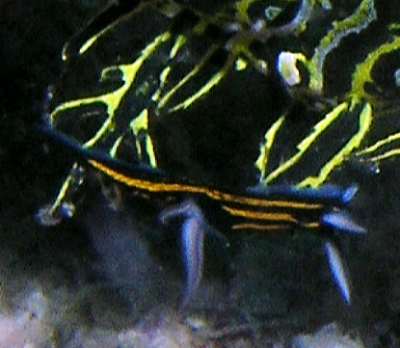
Dear Aaron,
Thanks for this. It is surprising how many nudibranchs seem to walk over scorpion fish. [The close-up alongside is of the fish's 'beard']. I know there are a few other examples on the Forum, one in fact showing a scorpion fish with nudibranch eggs deposited on its back [#12726 ]. And before anyone suggests that the remarkable colour similarity is a superb example of camouflage or mimicry, I think it is just a remarkable coincidence. I guess scorpaeinid fish, which sit still for long periods, are just another rock to a nudibranch.
The message you refer to, is about Roboastra eating another nudibranch. I am not sure if you are perhaps suggesting Roboastra may be eating the fish - or taking a nibble, As far as I know, species of Roboastra are purely nudibranch feeders.
Best wishes,
Bill Rudman
Re: Roboastra gracilis eating Nembrotha kubaryana
February 14, 2006
From: Rie Nakano
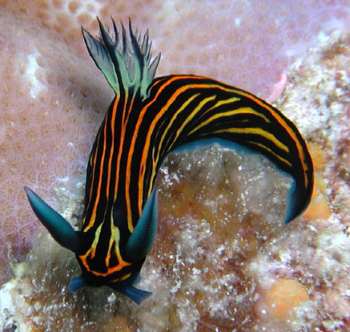
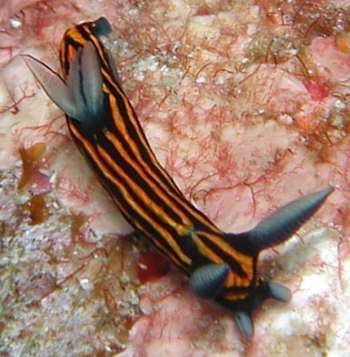
Concerning message #15816:
Dear Dr.Rudman and Mr.Ross Gudgeon,
I think this little predator is Roboastra luteolineata, not R. gracilis.
Here are two photos for comparison which were taken at the same place, at the same time.
Upper: Roboastra luteolineata is 40mm.
Lower: R.gracilis is 30mm.
Locality: Zamami Is., 7 metres, Okinawa, Japan, Pacific Ocean, Summer, 2004, Rocky shore. Photographer: Rie Nakano
Juvenile R. luteolineata is just like R. gracilis, but the color of the gills is obviously different.
Sincerely,
Rie Nakano
.
rie@divers.ne.jp
Rie Nakano, 2006 (Feb 14) Re: Roboastra gracilis eating Nembrotha kubaryana. [Message in] Sea Slug Forum. Australian Museum, Sydney. Available from http://www.seaslugforum.net/find/15851Dear Rie,
Thanks for your comments. I had my doubts about the identity of this little Roboastra but decided on R. gracilis for a number of reasons.
I wondered about the gills, but not so much with the colour, which seems ok, but with the number of gills. I usually expect there to be three but Pola, Cervera & Gosliner (2005) say there can be up to six. The feature that made me decide it was R. gracilis was the way the yellow lines joined in the midline behind the gills, as you can see in your photo of R. gracilis. In R. luteolineata the lines seem to run parallel on either side of the midline.
I may be quite wrong. Perhaps Marta, Lucas or Terry can give us their opinion.
-
Pola, M.., Cervera, J.L. & Gosliner, T.M. (2005) Review of the systematics of the genus Roboastra Bergh, 1877 (Nudibranchia, Polyceridae, Nembrothinae) with the description of a new species from the Galápagos Islands. Zoological Journal of the Linnean Society,144, 167–189. With 12 figures
Best wishes,
Bill Rudman
Roboastra gracilis eating Nembrotha kubaryana
February 13, 2006
From: Ross Gudgeon
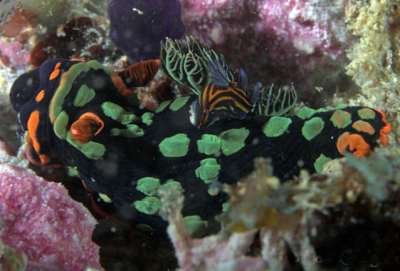
Concerning message #15757:
After witnessing the Nembrotha kubaryana being eaten by Roboastra luteolineata reported by Kristin, and seeing her great shots of that meal, I thought you might find this shot interesting. It was taken on the same reef a week earlier only 20 metres from where Kristin took her pictures. At the time I took them I thought that the Roboastra gracilis (I think??) was only hitching a ride, but after seeing Kristin's shot I think he may have been out for a very large meal.
Locality: Lighthouse Bay, Exmouth, 12 metres, Western Australia, Indian, 28 January 2006, Reef. Length: 6 mm. Photographer: Ross Gudgeon
Ross Gudgeon
ross@gudgeon.id.au
Gudgeon, R.I., 2006 (Feb 13) Roboastra gracilis eating Nembrotha kubaryana. [Message in] Sea Slug Forum. Australian Museum, Sydney. Available from http://www.seaslugforum.net/find/15816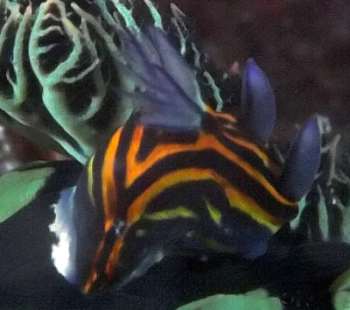
Dear Ross,
Usually not many days pass between really great discoveries being reported on the Forum, and I think your observation fits into that category. I have often wondered how juveniles of these hunters feed, or even how relatively small species like R. gracilis get on when only large prey are present. If you look at your close-up alongside, the white patch in the lower left of the photo, is the white flesh of the the prey. It has a black skin layer and then a very white muscle layer beneath. What your photo shows is that the Roboastra is not trying to swallow the whole Nembrotha as the R. luteolineata was attempting in Kristin's message, it is just chewing out manageable bits of the animal - eating it alive. I'm surprised the Nembrotha still has its gills and rhinophores extended - perhaps it has reached a pain threshold or perhaps the Roboastra is not actually biting at the moment. I have checked out earlier observations on species of Roboastra feeding and can't find any referring to this type of 'grazing'. Other reports seem to suggest 'engulfing' the whole prey is the standard procedure. If anyone has further information it would be very welcome.
To my knowledge, this is the first feeding record for Roboastra gracilis. Photos showing behaviour, ordinary or strange, are always welcome. As with this shot, you never know when you might photograph something extraordinary.
Best wishes,
Bill Rudman
Roboastra gracilis mating ritual
April 16, 2005
From: Karen Willshaw
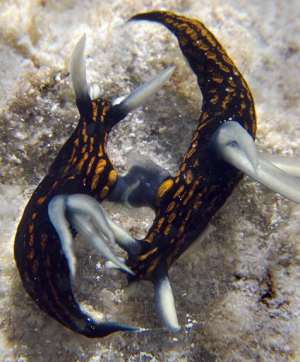
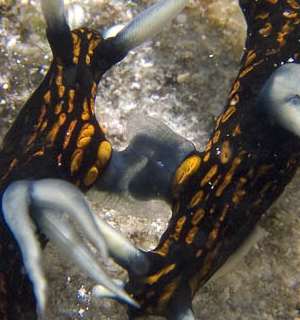
Hi Bill,
Greetings from the sandbar in the middle of the Indian Ocean - aka Cocos (Keeling) Islands. These two Roboastra gracilis were caught in the act. I do apologise for the clarity of the images, it was the best I could do at the time.
Locality: Cocos (Keeling) Islands, Australian Indian Ocean Territories. Indian Ocean. Depth: 14 metres. Length: 4 mm. 10 April 2005. rocky substrate & sand. Photographer: Karen Willshaw.
Karen Willshaw
karen@IkanImages.com
Willshaw, K., 2005 (Apr 16) Roboastra gracilis mating ritual. [Message in] Sea Slug Forum. Australian Museum, Sydney. Available from http://www.seaslugforum.net/find/13503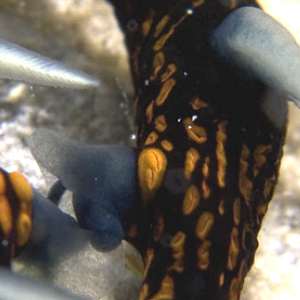
Thanks Karen,
I have often wondered if this species, which feeds on other nudibranchs, is partial to cannibalism. If so, it would make mating a dangerous pastime - as some spiders discover. I have included a close-up of the skin of one of your animals as it shows the nature of the yellow spots and lines on this species very well. You can clearly see a thin line across the yellow. This is a crack or opening to a deep fold or groove in each of these yellow regions, and the skin is highly glandular exuding a yellowish viscous secretion when the animal is disturbed. Species of Tambja and Nembrotha have similar glandular pits or grooves disguised as coloured lines.
Best wishes,
Bill Rudman
Roboastra gracilis from Mozambique
March 3, 2005
From: Riaan Marx
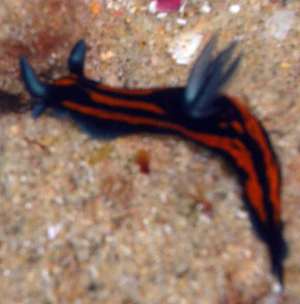
Dear Dr. Rudman,
I found some pictures on the web (what did we ever do without the web?) that resemble my nudi and call it Roboastra gracilis, but I am not totally convinced:
Although the general body form, colour pattern, rhinophore style and gill-style matches up, there are absolutely no yellow pigment and 4 gills, not 3 and the distribution does not match at all.
Locality: Ponta Malongane, Steps reef. Mozambique, Indian Ocean.
Depth: 10-12 m. Length: 30-35 mm. 8 February 2005. Very sandy patch in rocky reef. Photographer: Riaan Marx
Unfortunately the surge was horrible and I could not manage a better photo than this. I guess the question is - how common is morphological variations like this generally and specifically in this species?
Kind regards,
Riaan Marx
v-riaanm@microsoft.com
Marx, R., 2005 (Mar 3) Roboastra gracilis from Mozambique. [Message in] Sea Slug Forum. Australian Museum, Sydney. Available from http://www.seaslugforum.net/find/13250Dear Riaan,
It certainly falls within what I would consider the variation in this species. If you look at the other messages on the Forum the colour markings range from yellow to orange and can be either lines or spots or a combination. All 3 gills is common there are others with 4. Terry Gosliner [Nudibranchs of Southern Africa ] has a photo from Sodwana, South Africa, of an animal very similar in colour to yours
Most species show some variability in colour pattern, the trick is to work out by comparative anatomy and lots of material, just how much variation can occur in one species. That is one of the very valuable ways that amateurs, through the Forum, can help us learn more about these animals. There are many examples on the Forum of photos showing new colour variations in a species, and suggesting how perhaps 2 so-called species are in fact just colour forms of one. Photographs alone are not proof, but that certainly are a good way to guide scientists into asking the right questions.
Best wishes,
Bill Rudman
Roboastra gracilis from Malaysia [2]
September 12, 2003
From: Asther M. Lau
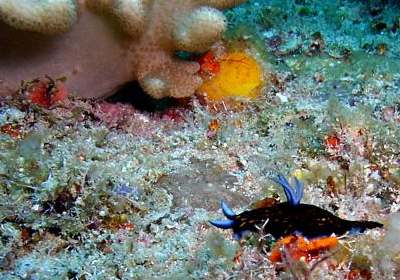
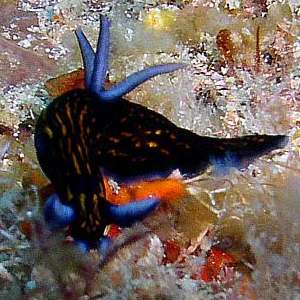
Hi again,
Thank you for your help in identifying the pics I took from my previous message on this Roboastra gracilis.
I went through my log book again and found a similar sample from my dive in Dayang Is., Johor Malaysia. As I recalled the dive, this cute little creature was found by Vivian Koh, one of our buddies. Thanx for her keen, sharp eyes, else we won't have been able to see it at all as it was really really small. Current was so strong on that dive but it managed to hang on to the big rock and crawled slowly and effortlessly. Amazing 'strength' there!
Site: Pinnacle II, Dayang Is. Malaysia
Depth: 16 meter
Date: May 17th, 2003
Size: 0.5cm
Photo taken by: Lim Eng Hoo
Asther M. Lau
diveworldwide@yahoo.com
Thanks Asther,
Bill Rudman
Roboastra gracilis from Malaysia
September 11, 2003
From: Asther M. Lau
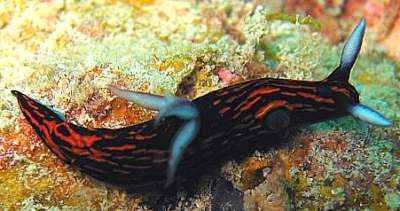
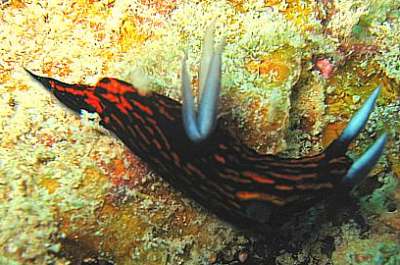
Hi again...
Found this one crawling away from another of same kind. It was crawling on the bottom of sand and rocks. No eggs were found so don't think they mated. There is a small opening on its right side near the rhinophore.
Site: Labas Is. Tioman, Malaysia
Depth: 15 meter
Date: 10th August 2003
Size: About 2.5 cm on crawling position
Please help identify.
Thank you!
Asther M. Lau
diveworldwide@yahoo.com
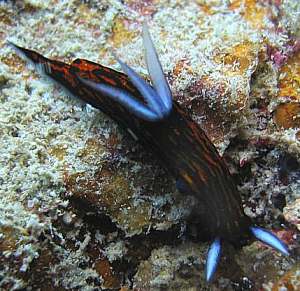
Dear Asther,
This is Roboastra gracilis. The orange marks can range from rows of spots to lines, but it is always recognisable by the proportionally large bluish gills and rhinophores
Best wishes
Bill Rudman
Roboastra gracilis from Saudi Arabia
July 18, 2002
From: John Chuk
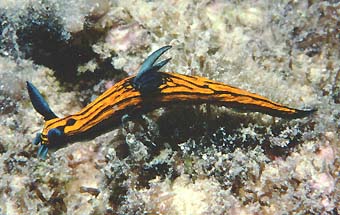
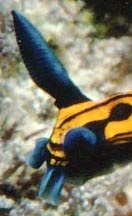
Dear Bill,
Here are images of a specimen of Roboastra gracilis photographed in the Red Sea at 'Black Mountain' dive site (about 550km south of Jeddah) on August 21 1992.
The specimen measured 25mm in length and was found crawling over filamentous algae on the reef flat at a depth of 2m. This was my first and only sighting of the species in the Red Sea. The second image is a close up showing the head in more detail.
Best wishes,
John.
jchuk@giant.net.au
Chuk, J., 2002 (Jul 18) Roboastra gracilis from Saudi Arabia. [Message in] Sea Slug Forum. Australian Museum, Sydney. Available from http://www.seaslugforum.net/find/7502Thanks John,
Usually the yellow lines are narrower than the blue-black background. In this animal the proportions are reversed. I have not seen many examples from the western Indian Ocean so I can't say whether this is a regional variation or not
Best wishes,
Bill Rudman
Roboastra gracilis from Malaysia
July 16, 2002
From: Richard Houghton
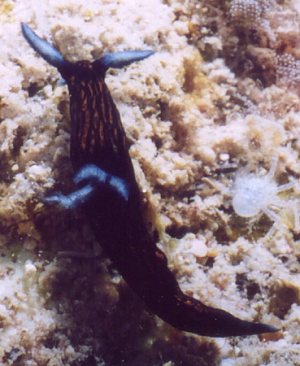
Bill,
Here is another photo of a Nudibranch found off Pulau Aur, Malaysia in May 2002.
Happy diving,
Rich
richard_houghton@hotmail.com
Houghton, R., 2002 (Jul 16) Roboastra gracilis from Malaysia. [Message in] Sea Slug Forum. Australian Museum, Sydney. Available from http://www.seaslugforum.net/find/7470Dear Rich,
This is Roboastra gracilis
Bill Rudman
Roboastra gracilis from west Malaysia
July 12, 2002
From: Kheong Sann Chan
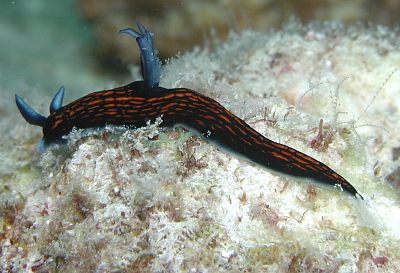
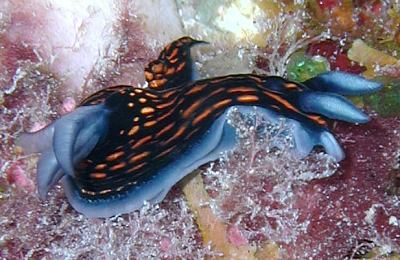
Here's a colourful guy that I haven't seen before, can you tell me its name? It's maybe 3cm long.
Location: Dayang, Dayang Channel, west coast Malaysia
Date: 8 June, 1130
Depth: 5m
Kheong
kschan@mail.dsi.nus.edu.sg
Chan, K.S., 2002 (Jul 12) Roboastra gracilis from west Malaysia. [Message in] Sea Slug Forum. Australian Museum, Sydney. Available from http://www.seaslugforum.net/find/7215Dear Kheong,
This is Roboastra gracilis. I guess you will have realised by now, that if you look at the other messages on a 'species' page, and the Fact Sheet, you will usually find some more information about the animal.
Cheers,
Bill Rudman
Roboastra gracilis from Fiji
October 23, 2001
From: Daniel Geiger

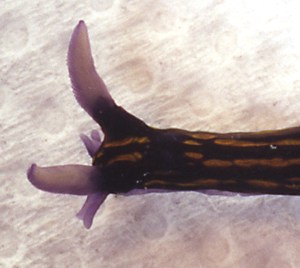
Hi Bill
Here are some photos of Roboastra gracilis from Fiji. Site #22, Sept. 2001, approx. 10 m depth, length approx. 25
mm fully extended, maybe 30 mm.
Daniel.
dgeiger@nhm.org
Geiger, D., 2001 (Oct 23) Roboastra gracilis from Fiji. [Message in] Sea Slug Forum. Australian Museum, Sydney. Available from http://www.seaslugforum.net/find/5441Thanks Daniel,
Bill Rudman
Roboastra gracilis from Australia
October 9, 2001
From: Marli Wakeling
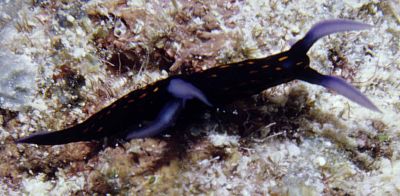
Hi Bill,
Here's another nudibranch, a Roboastra gracilis from my recent travels.
Location: Challenger Bay, Great Barrier Reef, Australia.
Depth: 7 metres
Length: 25mm
Photograph: Marli Wakeling
Marli
scubamarli@excite.com
Wakeling, M., 2001 (Oct 9) Roboastra gracilis from Australia. [Message in] Sea Slug Forum. Australian Museum, Sydney. Available from http://www.seaslugforum.net/find/5368Thanks Marli,
Although the yellow on the body is not very clear, the disproportionally large rhinophores are a very charcteristic feature of this species
Best wishes,
Bill Rudman
Roboastra gracilis from Fiji
July 22, 2001
From: Ken Tucker

I'm having trouble identifying this nudibranch, shot in Fiji while diving there this March. It was between 1.0" to 1.5" and found at Bligh Water, smack in the middle of the Vatu-i-ra Passage, which runs between Vanua Levu and Viti Levu.
Perhaps you can help.
Thanks much,
Ken
ken@kilili.com
Tucker, K., 2001 (Jul 22) Roboastra gracilis from Fiji. [Message in] Sea Slug Forum. Australian Museum, Sydney. Available from http://www.seaslugforum.net/find/4828Dear Ken,
This is Roboastra gracilis.
Best wishes,
Bill Rudman
Roboastra gracilis from the Solomon Islands
February 1, 2001
From: Mary Jane Adams
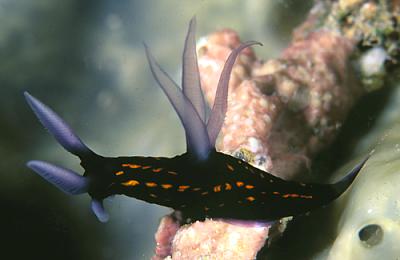
Hi Bill,
Here is another Roboastra gracilis from the Solomon Islands. This one was crawling rapidly over patch reef and coral rubble at 5 meters in the Sunlight Passage through the Russell group of islands. November, 2000
Best regards,
Mary Jane
divepng@yahoo.com
Adams, M.J., 2001 (Feb 1) Roboastra gracilis from the Solomon Islands. [Message in] Sea Slug Forum. Australian Museum, Sydney. Available from http://www.seaslugforum.net/find/3626Dear Mary Jane,
Thanks for the great photo which shows the huge oral 'tentacles' so well
Best wishes,
Bill Rudman
A spotted Roboastra gracilis
August 8, 2000
From: Mary Jane Adams
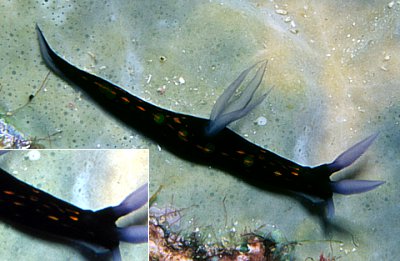
Hi Bill,
Can you ID this one? I found it crawling over coral in a mostly rubble bottomed bay in Mary Island, Solomon Islands. Black body with orange spots, blue-gray gills, lamellate purple rhinophores, gray foot.
Depth: 8 meters Crawling length: 24 mm November, 1997
Thanks!
Mary Jane
mjadams@earthlink.net
Adams, M.J., 2000 (Aug 8) A spotted Roboastra gracilis. [Message in] Sea Slug Forum. Australian Museum, Sydney. Available from http://www.seaslugforum.net/find/2835Dear Mary Jane,
I am pretty sure this is a colour form of Roboastra gracilis. I suspect the yellow-orange spots in this animal are in grooves, which in other specimens are completely yellow.
Have a look at Lindsay Warren's photo from Sulawesi, which shows an intermediate colour form. There are a number of names for orange or red spotted species which may all refer to the same species.
Best wishes,
Bill Rudman.
Roboastra gracilis from SE Sulawesi
July 18, 2000
From: Lindsay Warren
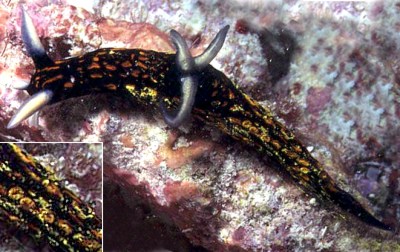
Dear Bill
I thought you might be interested in this shot of a Roboastra gracilis which, when disturbed, opened the orange 'pores' along its body and released an acid yellow looking fluid - presumably its defense mechanism.
Until that point the orange spots had been quite insignificant. Once the chemical had been released, they closed up again. I found this chap on 1 September 1999 at a depth of 59 ft on dead table coral 'wafting' upside down. L: 35-40 mm. Pulau Hoga, Tukang Besi Archipelago, SE Sulawesi, Indonesia (Operation Wallacea). Photo: Lindsay Warren.
All the best
Lindsay Warren
alldcl@compuserve.com
Warren, L., 2000 (Jul 18) Roboastra gracilis from SE Sulawesi. [Message in] Sea Slug Forum. Australian Museum, Sydney. Available from http://www.seaslugforum.net/find/2722Dear Lindsay,
Thanks for the photo. It is certainly a characteristic of this species to release this yellow secretion when disturbed. As you may have noticed, it can be a problem if you have other animals in a container with it, as it appears to be quite noxious to other sea slugs.
Best wishes,
Bill Rudman.
Spotted Roboastra gracilis from North Queensland
March 2, 2000
From: Paul Osmond
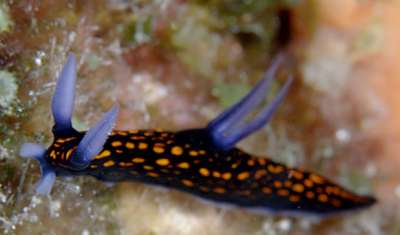
Hi Bill,
I thought these images may be of interest as it shows the spotted version of this nudibranch. For some reason I only seem to ever see and photograph the orange spotted version of Roboastra gracilis which I have seen in both Australia and in a couple of locations in The Philippines. From memory I believe I have never seen the fully striped version or least I have no images of the striped version.
This speciman was found on top of a sea mound at the Botek Koek dive site which is part of the Great Detached Reef system in far north Queensland.
Locality: Botek Koek, Great Detached Reef, 10m, Queensland, Australia, Pacific, 01 December 2005, Sea Mound / Bommie. Length: 30mm. Photographer: Paul Osmond.
Yours,
Paul
Deep Sea Images
marriard@deepseaimages.com
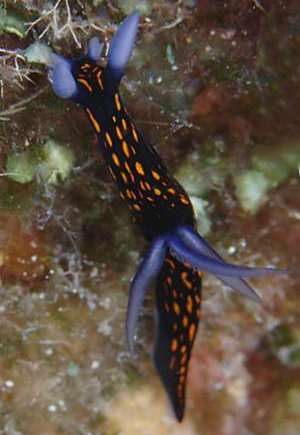
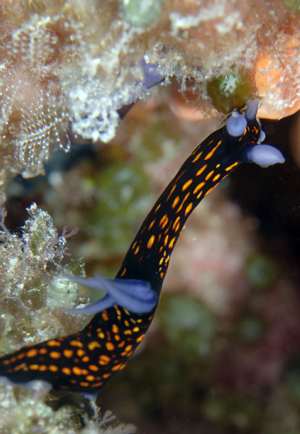
Thanks Paul,
Bill Rudman
